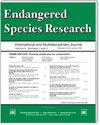DNA contamination and taxonomic diversity hinder eDNA research on freshwater stingray species: Comment on Lim & Then (2022)
IF 2.9
2区 环境科学与生态学
Q2 BIODIVERSITY CONSERVATION
引用次数: 1
Abstract
Recently, Lim & Then (2022; Endang Species Res 48:43-50) used an environmental DNA (eDNA) PCR-based method for detecting the presence of an endangered species of freshwater stingray, Fluvitrygon kittipongi (Dasyatidae), in the Pahang River basin, east Peninsular Malaysia. For that, they designed a species-specific pair of primers to amplify a 196 base pair (bp) fragment of the cytochrome c oxidase I (COI) gene. Lim & Then (2022) reported positive detection of this species along an upstream stretch of the Pahang River during the inter-monsoon and the southwest monsoon seasons, with the PCR-amplified eDNA sequences identical to the reference COI sequences of F. kittipongi collected from the Perak River basin, west Peninsular Malaysia. Here, we argue that such positive results are likely the consequence of a DNA contamination because the 196 bp COI fragments of F. kittipongi from the Pahang River and the Perak River differ from each other by 4 nucleotide substitutions. The source of contamination in Lim & Then (2022) could have been the Perak samples the authors handled to develop the primers. We also briefly discuss the potential impact of the presumed co-occurrence of freshwater stingrays of the genus Fluvitrygon in the Pahang River on the specificity of the F. kittipongi-specific primers designed by Lim & Then (2022).DNA污染和分类多样性阻碍淡水黄貂鱼物种的eDNA研究:评论Lim & Then (2022)
最近,Lim & Then (2022;Endang Species Res 48:43-50)使用基于环境DNA (eDNA) pcr的方法检测了马来西亚半岛东部彭恒河流域一种濒危淡水黄貂鱼Fluvitrygon kittipongi (Dasyatidae)的存在。为此,他们设计了一对物种特异性引物来扩增细胞色素c氧化酶I (COI)基因的196碱基对(bp)片段。Lim & Then(2022)报道了在季风间期和西南季风季节沿彭恒河上游检测到该物种的阳性结果,pcr扩增的eDNA序列与从马来西亚半岛西部Perak河流域收集的F. kittipongi参考COI序列相同。在这里,我们认为这样的阳性结果可能是DNA污染的结果,因为来自彭恒河和霹雳河的F. kittipongi的196 bp COI片段彼此有4个核苷酸取代。Lim & Then(2022)中的污染源可能是作者为开发引物而处理的霹雳州样品。我们还简要讨论了假定在彭恒河中共存的Fluvitrygon属淡水黄貂鱼对Lim和Then(2022)设计的F. kittipongi特异性引物的特异性的潜在影响。
本文章由计算机程序翻译,如有差异,请以英文原文为准。
求助全文
约1分钟内获得全文
求助全文
来源期刊

Endangered Species Research
BIODIVERSITY CONSERVATION-
CiteScore
5.50
自引率
6.50%
发文量
38
审稿时长
31 weeks
期刊介绍:
ESR is international and interdisciplinary. It covers all endangered forms of life on Earth, the threats faced by species and their habitats and the necessary steps that must be undertaken to ensure their conservation. ESR publishes high quality contributions reporting research on all species (and habitats) of conservation concern, whether they be classified as Near Threatened or Threatened (Endangered or Vulnerable) by the International Union for the Conservation of Nature and Natural Resources (IUCN) or highlighted as part of national or regional conservation strategies. Submissions on all aspects of conservation science are welcome.
 求助内容:
求助内容: 应助结果提醒方式:
应助结果提醒方式:


